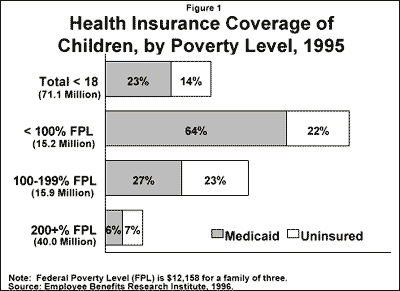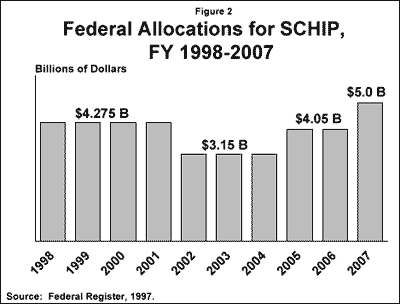Legislative Summary: State Children’s Health Insurance Program – Fact Sheet
State Children’s Health Insurance Program Summary
November 1997
Nearly 10 million children are uninsured, often resulting in difficulties in obtaining needed health care. To expand coverage to low-income uninsured children, Congress enacted the State Children’s Health Insurance Program (CHIP) as part of the Balanced Budget Act (BBA) of 1997 (P.L. 105-33). This new program allocates $20.3 billion in federal matching funds over five years to states to expand insurance for children. States can use the federal funds to expand coverage either through a separate state program or by broadening their Medicaid programs — or both.
Eligibility
The intent of CHIP is to expand health insurance coverage to uninsured children under age 19 in families with incomes below 200% of poverty (Figure 1). Children with private insurance or who are covered by or qualify for Medicaid are ineligible for CHIP, as are those who are residents of public institutions or whose families are eligible for state employee health benefits. Undocumented children and legally resident children arriving in the U.S. after August 22, 1996 are ineligible for coverage but may qualify for emergency Medicaid assistance. States that implement their child health insurance programs through Medicaid may use federal funds to cover legally resident children in the country prior to August 22, 1996.

States that choose to operate a separate state child insurance program can establish eligibility based on geographic area, age, income and resources, residency, and disability status, as well as limit duration of coverage. States cannot exclude children based upon a preexisting condition or diagnosis, and cannot cover higher income children before lower income children.
If states use the Medicaid option, children become entitled to full Medicaid coverage. States that have already broadened Medicaid income eligibility levels above 150% of the federal poverty level (FPL) can expand coverage to children up to 50 percentage points above the current level. For example, a state with eligibility set at 175% FPL could expand to 225% FPL.
Benefits and Cost-sharing
The benefit package options available to states fall into three general categories: Benchmark, benchmark-equivalent, or Medicaid.
- Benchmark Packages: States can offer one of three existing benefit packages: including the Federal Employees Blue Cross/Blue Shield PPO plan; coverage available to state employees; or coverage offered by the HMO with the state’s largest commercially enrolled population.
- Benchmark-Equivalent Coverage: States can use a package with aggregate value greater than or equal to a benchmark plan. Hospital, physician, laboratory and x-ray, and well baby/child services must be included at a value at least actuarially equivalent to the benchmark benefit package. If prescription drugs, mental health, vision, and hearing services are included in the benchmark plan, then they must be part of the benchmark-equivalent coverage with a value of at least 75% of the benchmark plan’s actuarial value.
- Medicaid: States that expand Medicaid must provide the complete benefit package, which includes well-child care, immunizations, prescription drugs, doctor visits, hospitalization, and EPSDT, as well as long-term care for disabled children. The Medicaid benefit package for children is broad and should satisfy the benchmark requirement in a state that administers a separate CHIP program.
The Secretary has the authority to approve a different benefit package that is determined to be appropriate for low-income children. The existing New York, Florida, and Pennsylvania child health programs are deemed to satisfy federal requirements for benefits.
Under the new program, states cannot impose cost-sharing for preventive services including well-baby and well-child care and immunizations. For children with family incomes below 150% FPL, cost-sharing must be “nominal” as under the Medicaid statute. Medicaid currently permits premiums of $15 to $19 per month per family and co-payments of up to $3 per service. Cost-sharing for children with incomes above 150% FPL can be imposed based on an income-related sliding scale, but total cost sharing cannot exceed 5% of family income. Coverage can be provided directly by the state Medicaid program, an insurer, or any other entity considered to be qualified by the state.
Financing
The BBA authorizes $20.3 billion in federal funds from FY 1998 through FY 2002 and $19.4 billion over the second five years. Over the ten-year period, the funds are allocated as follows: $4.275 billion per year in FY 1998-2001, falling to $3.15 billion annually in FY 2002 through 2004, and then rising to $4.05 billion from FY 2005 through 2006, and reaching $5 billion for 2007, for a total of $40 billion.

Annual federal allocations to states are based on the states’ share of low-income and uninsured children using estimates from the Current Population Survey, conducted by the U.S. Census Bureau. The allotment formula changes over time to adjust for reductions in the number of uninsured children.
States do not receive their allotments automatically. States must have their child health plan approved by HHS and are required to contribute state funds in order to draw down, or “match” their federal allotment. The state share cannot include beneficiary cost-sharing and is subject to the same provider tax and donation limitations specified in the Medicaid statute.
Under the new state program, states receive an “enhanced” federal matching rate based on their Medicaid matching rate. The CHIP enhanced rate essentially reduces by 30 percent the share states pay as compared to what they would contribute under their Medicaid match. For example, a state with a federal match of 60% under Medicaid would receive an “enhanced” rate of 72% under the new program. In essence, the state would pay 28 cents of every dollar spent under the new children’s program. No state may receive a matching rate greater than 85% and the minimum annual payment for a state is $2 million. States can receive an enhanced matching rate for providing Medicaid coverage to an expanded group of children. All Medicaid rules, including the entitlement to coverage, would apply to the newly covered group of children. States would continue to receive the regular Medicaid matching rate after their CHIP allotment was depleted.
While the states have considerable latitude in designing and structuring their CHIP programs, there are some limits on what federal CHIP payments can be used for:
- No more than 10 percent of federal payments can be used for outreach, administrative costs or direct service payments to clinics or hospitals. The Secretary can authorize waivers to allow states to create community-based programs or to purchase family coverage.
- States cannot adopt Medicaid eligibility criteria that are more restrictive than those in effect as of June 1, 1997.
- Maintenance of effort is also required in state-only programs in New York, Pennsylvania, and Florida.
- Abortions cannot be covered by federal or state funds except to save the life of the mother or in the case of rape or incest.
Child-Related Medicaid Provisions
In addition to the creation of the new state child health insurance program, several changes to Medicaid were made to strengthen coverage for children under the Balanced Budget Act of 1997. States can now opt to:
- Extend presumptive eligibility to children — This means that services provided to uninsured children will be covered by Medicaid before eligibility determination is complete. For children who are determined to be eligible for the new program, the costs will be paid through new program funds.
- Offer 12 month continuous eligibility to children — States can provide up to one year of continuous eligibility for children under Medicaid, regardless of any changes in family income during that period.
- Accelerate the phase-in to cover poor children born before September 30, 1983. In the past, states could cover these children under Section 1902(r)(2) at state option or through a Section 1115 waiver. The BBA of 1997 clarifies this option. Some 27 states have used these options to expand coverage to older children.
States must also restore Medicaid eligibility to disabled children who lost SSI under the 1996 welfare reform legislation. The Balanced Budget Act also includes numerous provisions that grant states increased flexibility over their Medicaid programs. These include the ability to mandate managed care enrollment without a waiver and greater control over provider payment through the repeal the Boren Amendment and a phase-out of cost-based reimbursement for Federally Qualified Health Centers.


